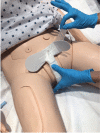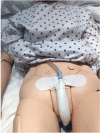Urinary Management With an External Female Collection Device
- PMID: 29394218
- PMCID: PMC5865498
- DOI: 10.1097/WON.0000000000000417
Urinary Management With an External Female Collection Device
Abstract
Background: Strategies to decrease use of female indwelling urinary catheters and catheter-associated urinary tract infections are challenging due to the limited availability of proper fitting external collection devices. Female urinary incontinence predisposes the skin to potential pain, itching, burning, infection, or pressure injuries.
Case studies: This article discusses 3 patients' trajectory of care with use of an external female urinary collection device. All of these females were incontinent of urine after the indwelling urinary catheter was removed and managed with an external female urinary collection device.
Conclusions: The use of an external female urinary collection device is a feasible alternative to an indwelling urinary catheter as well as managing urinary incontinence.
Figures
References
-
- Urinary Tract Infection (Catheter-Associated Urinary Tract Infection [CAUTI] and Non-Catheter Associated Urinary Tract Infection [UTI] and Other Urinary System Infection [USI] Events. Atlanta, GA: Centers for Disease Control and Prevention; 2017. http://www.cdc.gov/nhsn/PDFs/pscManual/7pscCAUTIcurrent.pdf. Accessed August 16, 2017.
-
- Lo E, Nicolle LE, Coffin SE, et al. Strategies to prevent catheter-associated urinary tract infections in acute care hospitals: 2014 update. Infect Control Hosp Epidemiol. 2014;35(5):464–479. - PubMed
-
- Gray M. Reducing catheter-associated urinary tract infection in the critical care unit. AACN Adv Crit Care. 2010;21(3):247–257. - PubMed
-
- Conner BT, Kelechi TJ, Nemeth LS, Mueller M, Edlund BJ, Krein SL. Exploring factors associated with nurses' adoption of an evidence-based practice to reduce duration of catheterization. J Nurs Care Qual. 2013;28(4):319–326. - PubMed
-
- Elpern EH, Killeen K, Ketchem A, Wiley A, Patel G, Lateef O. Reducing use of indwelling urinary catheters and associated urinary tract infections. Am J Crit Care. 2009;18(6):535–541. - PubMed
MeSH terms
LinkOut - more resources
Full Text Sources
Other Literature Sources
Medical



